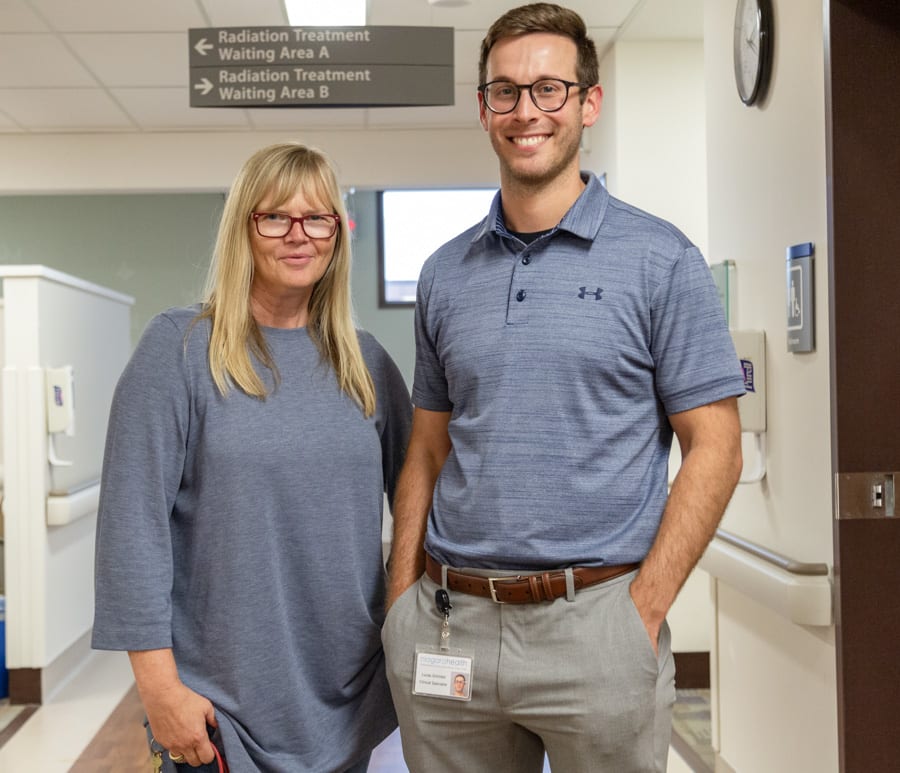We are Niagara Health is a series of stories that celebrates the incredible people working and volunteering in our organization and how they make a difference in the lives of patients and coworkers every day.

Clinical Specialist Radiation Therapists Julie Blain and Lucas Schinkel have helped to increase access to radiation treatment for patients at the Walker Family Cancer Centre in their role, which not every hospital is fortunate to have. Blain retired last month and Schinkel has taken over the reins entirely on the advanced practice role at Niagara Health.
Lucas Schinkel knows the Walker Family Cancer Centre (WFCC) is more effective at treating patients with cancer with the clinical specialist radiation therapist (CSRT) role that both he and Julie Blain fill.
That’s not ego talking. It’s the reality of being CSRTs and having their fingers on the pulse of just about everything happening in the WFCC to ensure patients receive safe, quality care in the timeliest way.
“The clinic would run less smoothly without this role,” Schinkel says. “We’re offloading the workload for the team here.”
CSRTs are medical radiation technologists (MRT) who use advanced clinical, technical and professional knowledge to collaborate with other members of the WFCC care team.
The advanced practice role, which often requires a master’s degree, was piloted by Cancer Care Ontario in 2006. Results since then show that having CSRTs on staff can increase access to radiation treatment by upping system capacity to accommodate more patients. That ultimately increases the quality of care and improves health outcomes.
Providing patient-centred care
At Niagara Health, Blain and Schinkel triage patients, do assessments and create care plans so patients can undergo treatment more quickly. Without them, physicians or other WFCC staff would have to take on that work, creating bottlenecks and slowing down their ability to provide critical hands-on care.
“We’re the face or voice of radiation therapy for patients,” Blain says. “We’re there to get them into and through treatment quickly and determine the best treatment route for them.”
Inspired by Blain, who retires this month, Schinkel transitioned to the role late last year.
“I decided to jump in with both feet,” says Schinkel, who came to Niagara Health from Hamilton Health Sciences’ Juravinski Cancer Centre as a radiation therapist in 2020. “There’s an advanced practice component where we’re able to help patients move more efficiently through the system and have better outcomes. There’s also a leadership component to support the department’s physicians and both of these appealed to me.”
Blain was Niagara Health’s first CSRT, starting when the WFCC opened in 2013. She travelled from Juravinski one day a week to help run a bone cancer metastasis clinic with Radiation Oncologist Dr. Bill MacMillan, who was medical director of Oncology at the time.
Blain already had five years of experience as a CSRT at Juravinski, an opportunity that arose when she upgraded her skills as a radiation therapist with her master of science (MSc) in radiotherapy and oncology.
In 2017, Blain joined Niagara Health full-time.
“Because we’re such a growing department and very busy, we had limited resources and this role was impactful in getting patients in and being seen, especially metastatic patients,” Blain says, adding patients whose cancer metastasizes are growing in number as treatments improve and more people live with cancer as a manageable, chronic illness.
A rare presence
Not every hospital, including those larger than Niagara Health, has a CSRT, even though the position has served as a model for cancer care in other provinces. But leadership here has supported and seen the value in the role.
“The Walker Family Cancer Centre is fortunate to have held two CSRT positions within the radiation program,” says Tracy Fazzari, Director of Patient Care, Oncology and Palliative Care. “Julie was a strong advocate for the need to consider a second CSRT, which led us to recruit Lucas, a frontline radiation therapist.
“In less than a year, he has supported complex treatment for patients with metastatic brain cancer, co-ordinating all neuro MRIs, seeing patients in the metastatic review clinic, participating in multidisciplinary rounds with radiation oncologists and surgeons, and receiving image fusion training with the head of physics as it pertains to patients with brain cancer,” she adds. “Lucas has engaged staff in ideal workflow, worked to reinstate the affiliation with Mohawk College and McMaster University to bring in radiation therapy students to the WFCC, and helped to develop a tracker for monitoring patient wait times.”
A profound impact
Blain’s impact goes beyond hand-picking a successor in Schinkel. During her time as a CSRT, she helped develop the Radium Program with Diagnostic Imaging, allowing for treatment of patients with metastatic prostate cancer.
She chaired or participated in committees, including the Lung Stereotactic Body Radiotherapy Working Group, and worked to bring stereotactic lung radiation therapy to Niagara in 2018.
She also assisted Orthopedic Surgeon Dr. Robert McCloy in establishing the Orthopedic Radiation Oncology Clinic (OROC) to assess risk fracture in patients with metastatic bone disease in weight-bearing bones. The clinic was modelled after a similar service she helped Dr. McCloy implement at Juravinski while doing her master’s degree.
With retirement on the horizon, Blain will turn her attention to a European vacation and channelling her passion for the arts into her next endeavour – but not without encouraging her fellow radiation therapists to consider the CSRT role in their career trajectories.
“It’s another awesome path for radiation therapists to go down,” Blain says. “Our role is instrumental when you look at Niagara Health.”

